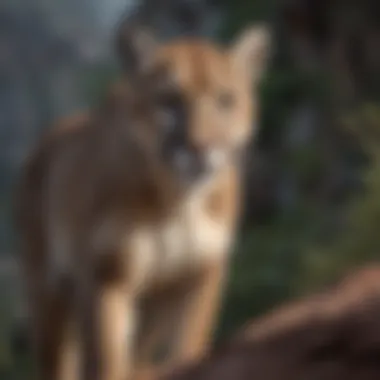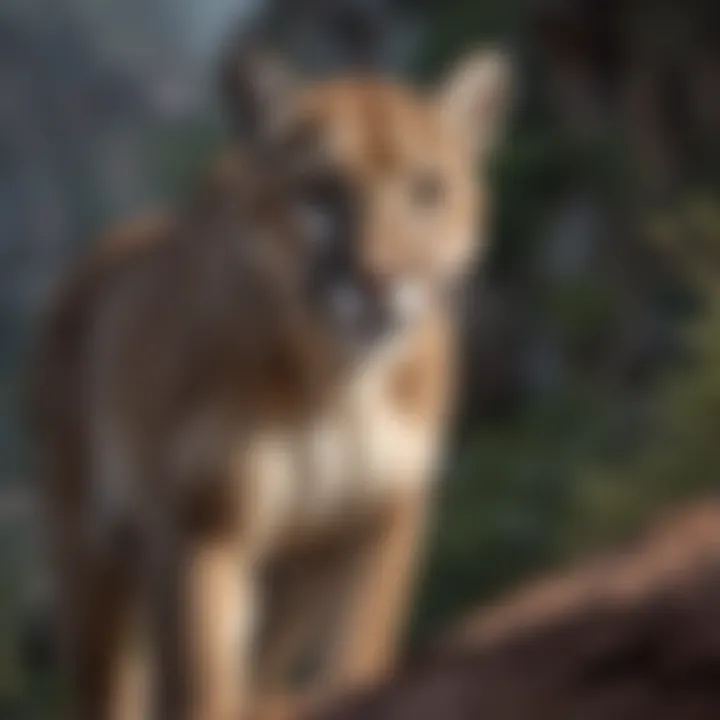Understanding Mountain Lion Size: Characteristics & Insights


Nature Topic Overview
Mountain lions, also known as cougars or pumas, are fascinating creatures that roam across North and South America. Understanding their size is key to grasping their behavior, habitat, and role in the ecosystem. Mountain lions are large cats known for their adaptability and stealth. In this overview, we delve into their physical dimensions, including average height, length, and weight, and how these factors relate to their hunting tactics and survival.
Mountain lions can vary significantly in size based on their geographical location and diet. For instance, mountain lions in the northern regions tend to be larger than those in the southern areas. This article dissects the elements influencing these size differences and highlights their ecological implications as apex predators, ultimately enhancing our understanding of this remarkable species.
Fun Facts and Trivia
Did you know that mountain lions can leap 40 feet in a single bound? This incredible ability allows them to navigate their rugged habitats with ease. Here are some more fun facts:
- A mountain lion's tail can be as long as its body, which helps with balance during jumps.
- They can weigh between 80 to 220 pounds.
- Unlike most big cats, mountain lions can roar, which they use to communicate with each other.
Visuals such as photos of mountain lions in their natural habitat can make learning exciting. Including interactive elements, like short quizzes, can also boost engagement and retention of facts.
Wildlife Explorations
Mountain lions share their habitats with various other species. Understanding these relationships provides insights into ecological balance. With their roles as top predators, they help control populations of deer and smaller mammals, preventing overgrazing and maintaining the health of their ecosystems.
In the mountainous regions where they often dwell, you can also find animals like:
- Black bears
- Bighorn sheep
- Various bird species, such as eagles
Quizzes or puzzles about these animals can make learning more engaging and enhance comprehension. Children could identify these animals from pictures or match them with their habitats.
Environmental Awareness
The survival of mountain lions depends on healthy ecosystems. Their role as apex predators is crucial in maintaining species balance. Understanding the importance of conservation is vital. Here are some tips on how children and families can help protect nature:
- Participate in local clean-up days in parks.
- Avoid littering during outdoor activities.
- Educate others about wildlife conservation.
By instilling these values, children learn the importance of sustainability.
DIY Nature Activities
Engaging with nature can foster a deep appreciation for wildlife. Here are some simple activities for kids:
- Create a Mountain Lion Habitat Model: Use materials like cardboard and markers to build a representation of a mountain lion's natural habitat.
- Nature Scavenger Hunt: Design a scavenger hunt in local parks to find various plants and animals, including those that mountain lions share their environment with.
- Crafting Educational Posters: Kids can make posters to showcase mountain lion facts, pictures, and their importance in the ecosystem.
These activities can effectively blend fun with education, encouraging a hands-on approach to learning about mountain lions and their habitats.
Remember, every effort counts in helping the environment and its wildlife. Together, we can protect these magnificent creatures and their homes.
Prolusion to Mountain Lions
Understanding mountain lions is vital for comprehending not only their biological characteristics but also their ecological roles. Mountain lions, also known as cougars or pumas, are elusive and fascinating members of the large cat family. Their size is one of the many physical attributes that draw interest. The significance of their size goes beyond mere measurements; it contributes to their survival strategies, hunting behaviors, and adaptation to various habitats.
In this article, we will delve into the defining aspects of mountain lions, their geographical distribution, and how their size can vary based on numerous factors. This foundational knowledge will inform the reader about the intricate relationship these animals have with their ecosystems. Understanding mountain lion size is essential for conservation efforts, as it allows researchers and wildlife enthusiasts to recognize the impacts of environmental changes on these apex predators.
Defining the Species


Mountain lions belong to the family Felidae and are classified scientifically as Puma concolor. This species is notable for its versatility and adaptability. They have a large range, spanning from Canada to South America, making them one of the most widespread wild cats in the Americas. Unlike many other big cats, mountain lions do not have a specific social structure, which allows them to be solitary animals, grazing or hunting alone.
Physically, mountain lions have a sleek and powerful body, with large paws and muscular limbs that allow them to excel in various environments. Their fur typically varies in color, primarily a tawny hue, but can also include shades of gray or brown, which provide excellent camouflage in their natural habitats.
Geographical Distribution
Mountain lions are found across diverse terrains, from rugged mountains to rural forests and semi-arid regions. Their range extends through several countries, including the United States, Canada, and parts of South America.
The following regions are particularly significant for mountain lions:
- Western North America: This area, which includes the Rocky Mountains, is home to one of the largest populations. States like California, Colorado, and Idaho are known for their robust mountain lion communities.
- South America: Mountain lions can be found in countries like Argentina and Chile, showing adaptability to both mountainous terrains and flatlands.
- Urban Areas: Interestingly, mountain lions have been observed adapting to urban environments, often seen traversing through suburban landscapes.
Understanding their geographical distribution is crucial for wildlife management and conservation. It informs protective measures and helps maintain healthy ecosystems, as mountain lions play a pivotal role in controlling prey populations.
"Mountain lions are not only a symbol of wild America but also vital to preserving ecological balance in their habitats."
Physical Dimensions of Mountain Lions
The physical dimensions of mountain lions are crucial in understanding their biology, behavior, and ecological role. These measurements not only provide insight into the health and vitality of the species but also help in studying their adaptability in varying environments. By analyzing aspects such as height, length, and weight, we can gain a clearer picture of their strengths and limitations. Additionally, these dimensions are vital when considering conservation efforts and habitat management strategies. A thorough understanding of mountain lion size can facilitate better decisions in preserving their populations and habitats.
Average Height and Length
Mountain lions typically exhibit a range of heights and lengths. On average, they stand between 24 to 30 inches tall at the shoulder and measure about 3 to 5.25 feet from the nose to the tip of the tail. The tail itself can add an additional 24 to 30 inches to their overall length. This variation in dimensions allows them to adapt to different terrains and hunting strategies.
Mountain lions’ long legs provide them with agility and speed. These features help them maneuver through rugged landscapes, which is essential for catching prey. In understanding their size, it is important to note how it correlates with their hunting prowess and territorial behavior.
Weight Variations Across Regions
Mountain lions show considerable weight variations that are largely influenced by geographical location. Adult mountain lions generally weigh between 64 to 220 pounds. Males are consistently heavier than females, often weighing 20 to 50 pounds more.
Importance of Regional Differences
Regional differences play a significant role in shaping the weight of mountain lions. In areas with abundant prey, such as deer, lions can attain heavier weights compared to those in regions with scarce food resources.
Being able to adapt to different environments demonstrates their resilience; this is a key characteristic of their ability to thrive across North America. The location also impacts factors such as hunting styles and reproductive success. Maintaining a healthy weight range is critical for their survival and reproductive rates.
Comparison with Other Big Cats
When comparing mountain lions with other big cats like tigers, lions, or leopards, one key characteristic emerges. Mountain lions are generally smaller than these counterparts but are similarly agile and adept in their hunting capabilities. Their size allows them to be versatile predators, thriving in diverse environments where larger big cats may not fit.
While mountain lions share traits with these larger cats, they occupy a unique ecological niche. Their adaptability and efficiency as solitary hunters highlight their evolutionary success. This differentiation in size and weight requires a tailored approach to conservation that considers their unique needs.
"Understanding the size of mountain lions is essential in appreciating their role as apex predators in various ecosystems."
Factors Influencing Size
Understanding the factors that influence the size of mountain lions is essential. These factors shape their physical development and ability to adapt to various environments. Analyzing such elements can lead to better conservation practices and a deeper appreciation for this apex predator.
Dietary Influences on Growth
Diet plays a crucial role in the growth of mountain lions. These big cats are primarily carnivorous. Their diet mainly consists of deer, elk, and smaller mammals. Access to rich, nutrient-dense prey can significantly impact their size. In regions where prey is abundant, mountain lions tend to grow bigger. Conversely, in areas with scarce food sources, their development may be stunted.


Mountain lions require a high protein intake to support their muscular bodies. Young cubs need special diets to ensure healthy growth. Besides meat, factors like the quality of their prey and seasonal availability also affect their nutrition.
- High-quality prey supports larger size.
- Limited prey leads to smaller dimensions.
As a result, conservation efforts that focus on maintaining healthy prey populations can directly influence mountain lion size.
Genetics and Size Variation
Genetic factors significantly contribute to size variation among mountain lions. Each population has different genes that dictate growth rates and physical development. For example, mountain lions in the Northern Rockies usually grow larger than in the southern regions of North America.
Breeding practices also influence genetic diversity. In areas where populations become isolated, inbreeding may occur. This leads to reduced size and health issues. Stressors from the environment also play a role. Factors such as habitat loss or pollution can pressure mountain lions and disrupt their growth.
- Genetic diversity ensures healthy growth.
- Isolated populations may face size limitations.
These genetic and environmental influences underscore the importance of ongoing research. Such studies can help in designing effective conservation strategies, ensuring a healthy population of mountain lions for the future.
Sexual Dimorphism in Mountain Lions
Understanding sexual dimorphism in mountain lions is essential to comprehend how these animals adapt and thrive in their environment. This concept refers to the differences in size and physical characteristics between male and female mountain lions. Such differences can influence behaviors, social dynamics, and reproductive success. Recognizing these nuances contributes to our overall view of the species and aids in conservation efforts.
Differences in Size Between Males and Females
Mountain lions demonstrate distinct size differences between the sexes. Male mountain lions typically are larger than females. On average, males can weigh between 120 to 220 pounds, while females generally weigh around 80 to 140 pounds. In terms of length, males can be up to 8 feet from head to tail, whereas females usually reach about 7 feet. This size disparity can be attributed to various factors, including dietary needs and reproductive roles.
The larger size of males may provide advantages when competing for territory or mates. These advantages can lead to greater gene propagation. However, being larger also comes with increased energy requirements. As such, males must secure larger territories with abundant prey. In contrast, smaller females can thrive with less space. However, their energy needs also reflect their roles as primary caretakers for cubs.
Reproductive Considerations
Reproductive strategies in mountain lions are significantly influenced by size differences between males and females. The larger males are often more successful in establishing dominance and attracting mates. This dominance hierarchy plays a crucial role during the mating season. Females, being smaller, can become selective when choosing mates. They may prefer larger males who can provide better protection and contribute to the safety of their offspring.
Moreover, the size differential affects cub survival. Larger males might claim territories that provide better resources, while the females' size allows them to remain hidden when raising cubs. Thus, the interplay between size and reproductive behavior intricately shapes population dynamics.
Understanding sexual dimorphism in mountain lions enhances our knowledge of their ecological roles. It emphasizes how physical attributes influence behavior and species survival.
Recognizing these reproductive considerations is critical for wildlife management and conservation planning. It helps inform strategies designed to maintain healthy populations and habitats for mountain lions and their prey, ensuring biodiversity preservation.
Growth Patterns in Mountain Lion Cubs
Understanding the growth patterns in mountain lion cubs is key to appreciating the species’ development and survival. Cubs represent the future generation of mountain lions, and their growth is influenced by various factors, including nutrition and parental care. Examining these elements allows us to better understand the dynamics of mountain lion populations and their role in the ecosystem.
Early Development Stages
Mountain lion cubs enter the world blind and helpless. At birth, they typically weigh about one to two pounds. For the first few weeks, they rely entirely on their mother for warmth and nourishment. During this early development, they remain hidden in a secure area, providing protection from predators. The mother will move them as needed to ensure their safety.
As cubs grow, they gradually develop vital skills. Their eyes open around ten days after birth, and they start to crawl and explore their surroundings. By the age of two months, they begin to eat solid food, though nursing continues for several more months. Understanding these stages enhances insight into their survival strategies and challenges.
Factors Affecting Cub Growth
Several factors contribute to the growth of mountain lion cubs, notably nutritional needs and parental care. Both elements are interlinked and play a crucial role in their development.
Nutritional Needs


Proper nutrition is fundamental for the growth of mountain lion cubs. Initially, they rely on their mother’s milk, which is rich in fat and protein. This diet is crucial as it supplies the necessary energy for rapid growth. Cubs begin to transition to meat around the age of two months.
Key Characteristics: The shift to solid food is vital. It marks an essential stage in their development. As they learn to hunt, they also learn about their environment.
Benefits: Adequate nutrition leads to better growth rates and improved health. This aspect ensures that cubs develop essential skills required for survival.
Unique Features: The type of prey available influences their nutritional intake. In regions with abundant deer, for example, cubs gain weight more quickly than those in areas where food is scarce.
Parental Care
Parental care significantly impacts the overall well-being of mountain lion cubs. The mother plays a pivotal role in teaching her young how to hunt and survive.
Key Characteristics: Maternal care involves not just feeding but also protecting and educating cubs. The mother stays close, fostering a safe environment where cubs can grow and learn.
Benefits: Active involvement of the mother leads to well-rounded cubs. They become capable hunters and contribute to the species in the future.
Unique Features: The mother uses varied approaches to train them, initially bringing back small prey to encourage their hunting instincts.
"Mountain lions rely on their mothers for the first year of life. The foundation laid during this time is crucial for their future success as apex predators."
This knowledge aids in conservation efforts, ensuring that these remarkable animals continue to thrive in their natural habitats.
Ecological Role of Mountain Lions
Mountain lions, also known as cougars or pumas, play a significant role in their ecosystems. Understanding their ecology is vital to grasping their importance in maintaining the balance of nature. By studying their behaviors and interactions with other species, we can appreciate how they influence biodiversity in their habitats.
Apex Predator Status
As apex predators, mountain lions sit at the top of the food chain. This status is crucial for several reasons. First, they help to regulate prey populations, preventing overgrazing and maintaining healthy ecosystems. When mountain lions hunt, they typically target the weak and sick animals. This natural selection process strengthens the gene pool of prey species. It ensures that only the fittest individuals survive to reproduce.
Moreover, mountain lions can indirectly affect plant life. By controlling herbivore numbers, they allow various plant species to flourish. This diversity in plant life contributes to a rich ecosystem, providing food and shelter for numerous other species.
"A well-balanced ecosystem thrives on the presence of predators like mountain lions, which keep herbivore populations in check and foster biodiversity."
Impact on Prey Populations
The impact of mountain lions on prey populations is profound. They primarily hunt deer, which constitute a large part of their diet. In areas where they roam freely, deer populations remain stable. This balance is necessary to support not just the deer but other species that share the same habitat. If mountain lions were to disappear, deer populations could explode. This scenario leads to overgrazing, which can devastate plant communities.
The consequences extend beyond just deer. Each species in an ecosystem relies on others for survival. For example, an increase in deer might lead to a decline in various plant species. This decline can create ripple effects throughout the ecosystem, affecting everything from insects to larger mammals that depend on those plants.
End
Understanding the size of mountain lions is crucial for various reasons. In this article, we have explored their physical dimensions, growth patterns, and ecological roles. Mountain lions play key roles in their environments as apex predators. When we grasp their sizes, it helps us comprehend their hunting abilities and territorial needs.
Summary of Key Findings
Mountain lions exhibit sexual dimorphism, with males generally larger than females. The average length of a mountain lion can range from about 3.25 to 5.25 feet, excluding the tail. Weight can vary, often from 75 to 220 pounds. Geographic factors significantly influence these variations. Regions with ample prey often host larger mountain lions. Diet also contributes to growth and health.
In early stages, mountain lion cubs depend on maternal care and nutrition, affecting their future size and health.
"Mountain lions demonstrate an intricate balance of size, diet, and ecological function. Their size is not just a number; it represents their role in the ecosystem."
Importance of Size in Conservation Efforts
The size of mountain lions holds significance beyond mere numbers. It becomes essential in conservation strategies. Large mountain lions are typically healthy and thriving, representing ecosystem stability. Knowledge of their size informs habitat preservation methods. Conservationists strive to maintain the balance of prey and predator.
Understanding their size helps in fostering human-wildlife coexistence. This entails protecting mountain lion habitats while ensuring the safety of nearby human populations. By preserving the natural balance, mountain lions can thrive in their environments while contributing to ecological health. This is vital for ensuring diverse wildlife for future generations.







